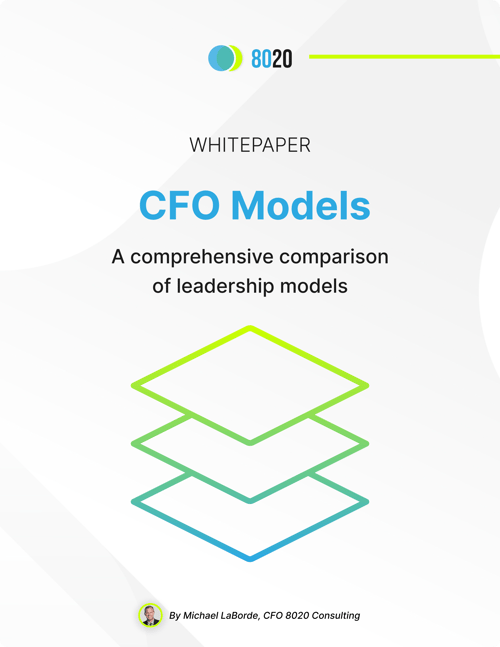WHITEPAPER
CFO Models
A comprehensive comparison of leadership models
This document provides a comprehensive comparison of three distinct financial leadership models: Outsourced CFO (Chief Financial Officer), Fractional CFO, and Interim CFO. Each model offers unique advantages and is suited to different organizational needs and circumstances. We’ll evaluate these models based on criteria such as cost-effectiveness, flexibility, expertise, and the specific needs of the organization. It provides insights into the scenarios where each model is most effective and offers recommendations for businesses considering these options.

SECTION 1 Outsourced CFO

An Outsourced CFO is a financial expert that provides high-level financial management and strategic services to a company sometimes on a part-time basis. Unlike a full-time, in-house CFO, an outsourced CFO is not a permanent employee but rather an external consultant who offers their expertise to help businesses manage their financial operations, plan for growth, and achieve their financial goals. This model is ideal for small to mid-sized companies that need high-level financial expertise without the expense of a full-time executive. Although not permanent, this model can involve full-time work (40+ hours per week) but typically for a short-term duration. The key distinction of this model is that an Outsourced CFO is usually engaged for a specific, non-recurring project that requires specialized expertise.
Use cases may include:
- Preparing for an IPO
- Acquisitions
- Fundraising
- Financial restructuring
Benefits
Cost Effective
Provides access to high-level financial expertise without the expense of a full-time executive salary and benefits.
Flexibility
Services can be tailored to the specific needs and scale of the business, allowing for scalability as the company grows.
Expertise
Brings a wealth of experience and industry knowledge, often from working with multiple companies across various sectors.
Objective Perspective
Offers an external, unbiased viewpoint that can help identify issues and opportunities that internal staff might overlook.
Closing Notes
While many CFO’s have a wide range of responsibilities, for this particular model, its best to prioritize the company’s needs and search for an Outsourced CFO that specializes in that or those areas.
SECTION 2 Fractional CFO

A Fractional CFO is a financial executive who provides CFO-level services to a company on a part-time, as-needed basis. Unlike a full-time CFO, a Fractional CFO works with multiple clients, dedicating a portion of their time to each, which allows businesses to access high-level financial expertise without the cost of a full-time executive.
Unlike the Outsourced model, the Fractional CFO is typically engaged on a recurringvbasis rather than for specific projects. Companies that might choose this model include startups, small to mid-sized enterprises (SMEs), businesses experiencing significant growth, and organizations undergoing transitional periods. Each of these scenarios may require ongoing financial operational sophistication and expertise.
Use cases or key responsibilities may include:
- Financial Reporting
- Budgeting and Forecasting
- Cash Flow Management
- Compliance and Governance
- Financial Strategy and Planning
- Lender and shareholder relationships
Benefits
Benefits of this model are similar to the Outsourced model including being (1) cost effective, (2) flexible, (3) expertise, (4) an objective perspective but also includes (5) ongoing support. The CFO in this model will often be integrated with the company’s executive team.
Closing Notes
This model allows companies to benefit from high-level financial management without the commitment and cost of a full-time CFO, making it an attractive option for many organizations. Although not fulltime, this model can serve as a mentor for junior staff.
As the company grows, the needs of the CFO will also grow, and the next logical step is to bring in a fulltime CFO or if applicable, promote a CFO from within. While specific skills or experience may be necessary for the Outsourced CFO model for a particular project (such as IPO readiness), the Fractional CFO model often places greater importance on a CFO who has experience in helping companies grow, establishing processes, or mentoring staff. Since the Fractional CFO will become part of the executive team, building trust and rapport, especially between the CFO and CEO, is crucial. While industry experience can be valuable, it is not always essential. Depending
on the industry, other qualities or experiences, such as a strong relationship with the CEO or a proven track record of helping companies grow, may be more important than specific industry experience.
SECTION 3 Interim CFO

An Interim CFO (Chief Financial Officer) is a temporary, full-time financial executive brought in to manage a company's financial operations during a transitional period. This role is typically filled when a company is undergoing significant changes, such as a leadership transition, financial restructuring, crisis management, or during the search for a permanent CFO. The Interim CFO provides immediate, hands-on leadership to stabilize and guide the company's financial functions.
While there are similarities to the Fractional CFO, the Interim CFO is fulltime, works with
just one company and the scope of responsibilities is much greater. With the exception of possibly a Startup Company, the need for an Interim CFO can span industries, company size and ownership structures.
Key Responsibilities:
- Leadership Transition:
Providing continuity and leadership during the transition to a new permanent CFO, including onboarding and knowledge transfer. This is often the main reason why companies use an Interim CFO. - Stabilizing Financial Operations:
Quickly assessing the current financial situation and implementing measures to stabilize operations. - Expertise:
Brings a wealth of experience and industry knowledge, often from working
with multiple companies across various sectors. - Crisis Management:
Addressing urgent financial issues, managing cash flow, and ensuring the company can meet its short-term obligations. - Strategic Planning: Developing and executing financial strategies to navigate the transitional period and support long-term goals.
- Financial Reporting and Analysis:
Preparing and analyzing financial statements and reports to provide insights into the company's financial health. - Risk Management:
Identifying and mitigating financial risks to protect the company's assets and ensure stability. - Operational Efficiency:
Identifying opportunities to improve financial processes and operational efficiency. - Stakeholder Communication:
Maintaining clear communication with stakeholders, including the board of directors, investors, and employees, to ensure transparency and confidence. - Hiring Resource:
Often the CFO participates in the hiring process of the fulltime CFO. Being the interim CFO provides a different perspective than others, and having the experience in the role, the Interim CFO is uniquely qualified to know what it takes to be successful in the role.
Closing Notes
As someone who has served as an Interim CFO, I have some advice to offer. Often, an Interim CFO may aim to maintain the status quo, but they may also identify opportunities for improvement and suggest changes. Similar to the Fractional CFO model, the Interim CFO is typically integrated into the Executive Team. Before implementing any significant changes, it is crucial to discuss these suggestions with the team and assess whether the changes should be made immediately or if it would be more prudent to wait and have the Interim CFO collaborate with the incoming full-time CFO to ensure their agreement. It is important to avoid making changes only to have to revise them again once the full-time CFO is hired.
For example, during my tenure as an Interim CFO, I noticed that the monthly financial reporting package was outdated, time-consuming to organize, and difficult to distribute across our global offices. I made suggestions to the Executive Team and General Managers of the respective offices. Since we were only 2 months away from hiring a full-time CFO, and the change would impact dozens of employees and offices, we decided it was best to wait. I provided the suggestion and relevant information to the incoming full-time CFO and assisted with the changes during the transition. This approach allowed the changes to be implemented smoothly within two months of the new CFO's hire.
Summary
When choosing the right CFO model, companies should consider their specific needs, budget, and the nature of their financial challenges.